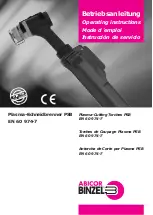
Rev. 3/7/2017
D-FORK, MANUAL
Copyright 2017 Vestil Manufacturing Corp. 4 of 5
Use instructions:
Capacity information for each D-FORK model appears in “Product specifications” on p. 2. Do not try to lift loads
that weigh more than the capacity of your unit.
Position the D-FORK along the length of the tines based on the capacity of your fork truck; then securely attach the
device to the tines using
both
the clamping bolts (item no. 2 above) and the nylon safety strap (item no. 6). First,
tighten the clamping bolts against the underside of the tines, and then attach the safety strap to the fork carriage.
Wrap the strap around a part of the carriage and attach the hook to the strap. There should be no slack in the strap.
Because this product is a fork attachment, you should request that the fork truck manufacturer or a professional
engineer determine how its use will affect the capacity, operation and maintenance of your fork truck. Plates, tags,
labels, etc. affixed to the truck should be changed accordingly. The truck should also be marked to identify the D-
FORK attachment and display the approximate weight of the truck and attachment combination at maximum elevation
with load laterally centered. (See 29 CFR 1910.178).
Firmly tighten the knobs against the underside of the tines; then wrap the safety strap around the fork carriage.
Attach the hook at the end of the safety strap
to
the safety strap. The strap must be wrapped around the carriage a
sufficient number of times so that there is no slack in the strap. Tilt the forks back slightly
Loading instructions:
Capacity information is cast on the surface of the hook. It indicates the net capacity of the hook in pounds. The
capacity is also displayed on tag 023 (see “Labeling Diagram” below).
Connect the load to the D-FORK in a manner that will minimize load swing when it is lifted off of the ground. Swinging
loads might cause injuries and/or damage equipment.
Inspections and maintenance:
(A) Before each use and AT LEAST once per month, inspect the following:
1.) Spring latch: Confirm normal condition and proper operation of the
spring latch of the lifting hook.
2.) Lifting hook mechanisms (-SL models only): Check for excessive
wear, looseness or damage to the shackle, hook swivel, lifting hook,
or the point of attachment to the main body of the D-FORK.
3.) Frame: Inspect the main body for deformation, cracking, etc.
4.) 4in. threaded knobs: Check the bolts for deformation, excessive
wear, cracks, or other structural damage.
5.) Safety strap: Closely examine the strap, snap hook, and the hook at
the free end of the strap. Look for thinned, frayed, torn, or
significantly worn areas.
6.) Labels: Examine the labels (see diagram below). Confirm that each
label is present, readable, and in good condition.
(B) Yearly inspection
Once per year, load the D-FORK to full rated capacity. Observe the hook, shackle and swivel (-SL models) from a
safe distance for looseness and for deflection of any of the hoisting hook parts. Lift the load for about 1 minute; then
lower it and disconnect the load from the lifting hook. After the load is removed, closely inspect all parts and surfaces
of the entire D-FORK for fatigue, cracks or deformation. If any significant damage is observed, remove the D-FORK
from service.
Labeling diagram:
The product should be labeled as shown in the diagram below. Replace any label that is missing, damaged or
unreadable.
FIG. 2: Parts of Lifting hook
Swivel
Spring
latch
Lifting
hook
Tag 023: Product data tag
Connected via zip tie to handle
Label 524: Proper use instructions
Applied to back side of tag 023























